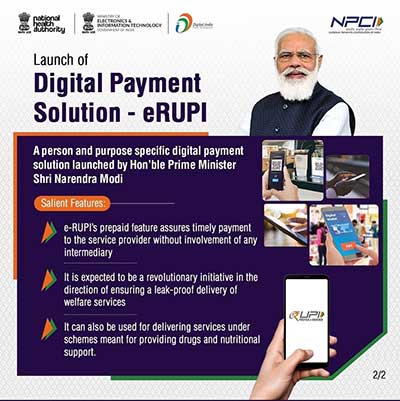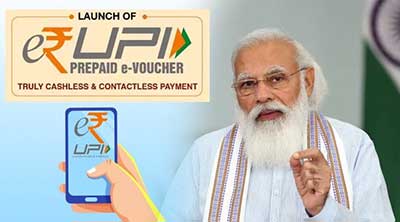Relevance: GS-3: Science and Technology- developments and their applications and effects in everyday life.
Key phrases: e-Rupi, Digital voucher, QR code, pre-paid voucher, one-time contactless, Reserve Bank of India, NPCI
Why in News?
- The increase in the e-Rupi voucher cap to ₹1 lakh will boost digital payments in the offline mode and allow direct benefit transfers without having to have a bank account, experts said.
Status of digital payment in India:
- The value of digital payments in India will grow three-fold to touch $1 trillion by financial year 2026 compared to $300 billion in financial year 2021 thanks to the government's initiative to increase financial access by combining no-frill bank accounts, the Aadhaar card and mobile connection, according to a report by CLSA.
- UPI comprises 60% of total payments by volume and digital payments have risen from $61bn in FY16 to $300bn as of FY21. Given increasing online purchases and digital adoption, we expect this to grow to US$0.9-1tn by FY26, or 30% of Indian consumption.
- Since its inception in 2016, the value of monthly UPI transactions took four years to cross the Rs 3-lakh-crore mark in September 2020. And in a year, it more than doubled to Rs 7 lakh crore.

What is e-RUPI?
- e-RUPI is basically a digital voucher which a beneficiary gets on his phone in the form of an SMS or QR code. It is a pre-paid voucher, which he/she can go and redeem it at any centre that accepts its.
- e-RUPI is a one-time contactless, cashless voucher-based mode of payment that helps users redeem the voucher without a card, digital payments app, or internet banking access.
- e-RUPI should not be confused with Digital Currency which the Reserve Bank of India is contemplating. Instead e-RUPI is a person specific, even purpose specific digital voucher.
- The National Payments Corporation of India (NPCI), which oversees the digital payments ecosystem in India, has launched e-RUPI, a voucher-based payments system to promote cashless transactions.
- It has been developed in collaboration with the Department of Financial Services, Ministry of Health & Family Welfare and National Health Authority.

How will e-RUPI work?
- e-RUPI is a cashless and contactless digital payments medium, which will be delivered to mobile phones of beneficiaries in form of an SMS-string or a QR code.
- This will essentially be like a prepaid gift-voucher that will be redeemable at specific accepting centres without any credit or debit card, a mobile app or internet banking.
- e-RUPI will connect the sponsors of the services with the beneficiaries and service providers in a digital manner without any physical interface.
Advantages of e-RUPI:
- e-RUPI does not require the beneficiary to have a bank account, a major distinguishing feature as compared to other digital payment forms. It ensures an easy, contactless two-step redemption process that does not require sharing of personal details either.
- Another advantage is that e-RUPI is operable on basic phones also, and hence it can be used by persons who do not own smart-phones.
- Being a prepaid voucher, e-RUPI would assure real time payments to the service provider.
- In payment through e-RUPI, there is no need of internet connection as compared to other digital payment system.
- Since, there is no need for physical issuance of vouchers, it will also lead to some cost savings as well.
Potential of e-RUPI:
- It will ensure better digital delivery of benefits of the central and state government schemes to the beneficiaries. Hence, it is likely to play a major role in strengthening direct benefit transfer (DBT) to citizens at the last mile, making it more transparent.
- e-Rupi’s key benefit for governments is in enabling penetration among the unbanked and feature phone users, allowing issue without needing the recipient’s bank account or KYC.
- e-Rupi would also interest the private sector and micro, small and medium enterprises (MSMEs) to deliver employee benefits besides exploring a wide range of business-to-business transactions.
- This payment platform will be prepaid in nature which does not require any kind of intermediary to make payment of the service provider. Other than that this platform can also be used for delivering services under schemes that are meant for providing drugs and nutritional support like mother and child welfare scheme, Ex. TB eradication program, drug and diagnostic under a scheme like Ayushmann Bharat Pradhan Mantri Jan Arogya Yojana, fertilizer subsidies, etc.
- Leak-proof revolutionary delivery of welfare services will be ensured through this initiative.
- In the midst of the pandemic, the government had done cash transfers to Jan-Dhan accounts of underprivileged citizens as part of its stimulus package. While the move did provide relief, it led to large queues in rural branches. With e-Rupi, the government can specify the end use of the money.
Way forward:
- The e-RUPI solution has been introduced in the backdrop of the policy objectives of the Government of India for financial inclusion. The aim appears to be to evolve the acceptance infrastructure for offline solutions to cater to under-served areas, the under-banked demographic, and non-smartphone users across India.
- Given that the e-RUPI does not require the beneficiaries to have a bank account or a mobile application (compared to other digital payment instruments), nor require them to have a smart phone, e-RUPI may witness a higher adoption rate in rural and remote parts of India, compared to the existing pre-paid payment instruments.
- e-Rupi vouchers are currently being used largely for Covid vaccination purposes. There are other use cases being actively considered by various states and central government. This will further facilitate the delivery of various government schemes to the beneficiaries more efficiently.
- However, as this solution evolves, the NPCI and other participants in the ecosystem will need to ensure that the cyber security framework backing the e-RUPI is robust (for instance, to prevent phishing attacks) and the e-vouchers are only redeemable once.
- Safeguards must also be put in place so that the risk of any misuse of the e-RUPI solution at the point of redemption is addressed, including where the SMS-string or QR code is shared with another person.
Source: Live Mint
Mains Question:
Q. India is among the fastest-growing nations when it comes to adopting digital payment systems. But, when it comes to rural households, there is still a long way to go. In this context, will e-RUPI succeed in bringing rural households under fold of digital payment system? Critically examine with example.









